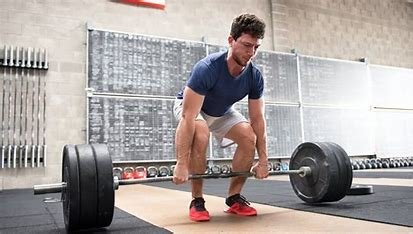Deadlifts are one of the most effective strength-training exercises, engaging a variety of muscle groups, especially the hamstrings, glutes, lower back, and core. However, because of the heavy loads typically involved, it’s crucial to perform the exercise with proper form to avoid injury.

1. Set Up Proper Foot Position
- Feet: Place your feet about hip-width apart, with your toes pointing forward or slightly outward. The barbell should be directly over the middle of your feet, which are typically about an inch or two away from the bar.
- Barbell: Make sure the barbell is close to your shins, but not touching them.
2. Grip the Barbell
- Grip Width: Bend down and grasp the bar with your hands just outside your knees. You can use a double overhand grip (both palms facing you) or a mixed grip (one palm facing you and the other facing away), depending on what feels most comfortable or necessary for grip strength.
- Grip Strength: Ensure your grip on the bar is firm, and you feel confident holding it before beginning the lift.
3. Engage Your Core
- Bracing: Take a deep breath into your abdomen (not your chest), and brace your core as if you’re about to be punched in the stomach. This will help create intra-abdominal pressure, stabilizing your spine.
- Neutral Spine: Keep your back straight, not rounded. Imagine trying to flatten your lower back as you prepare for the lift. Your spine should remain in a neutral position throughout the movement, maintaining its natural curve.
4. Hinge at the Hips (Not the Back)
- Hips First: Begin the movement by driving your hips back (not down) as if you’re pushing your butt toward the wall behind you. Your knees should bend slightly as your hips move back, but your torso should not drop too far toward the ground.
- Maintain Tension: As you push your hips back, maintain tension in your hamstrings, glutes, and lower back. Avoid letting your back round forward—this could put significant stress on your spine.
5. Lift the Bar
- Push Through Your Heels: When you start to stand up, push through your heels and engage your glutes, hamstrings, and core. The movement should be driven by your hips, not your lower back.
- Pull the Bar Up: As you rise, the bar should stay very close to your body, almost grazing your shins and thighs. Keep the bar in a vertical line.
- Avoid Overextending: Once the bar passes your knees and you’re standing upright, don’t lean back or hyperextend your lower back. Stand tall with your chest up and your shoulders back.
6. Lower the Bar Safely
- Hinge Again: To lower the bar, push your hips back (again, not down) and bend your knees once the bar passes them. Keep the bar close to your body, and control the descent—don’t let gravity take over.
- Avoid Rounding Your Back: Ensure your back remains straight and neutral as you lower the weight. Don’t let your spine curve under the load.
- Set the Bar Down: Gently place the bar back on the ground by hinging at the hips and bending your knees once the bar passes your thighs.
7. Breathe Properly
- Breathing: Remember to breathe throughout the lift. Inhale as you prepare to lift the bar, brace your core, and exhale once you’re at the top. Take another deep breath before each rep to maintain core stability.
8. Common Mistakes to Avoid
- Rounding the Back: One of the most dangerous mistakes is rounding the lower back, which increases the risk of disc herniation or other spinal injuries. Always focus on maintaining a neutral spine.
- Lifting with the Back: A common mistake is using the back to lift the bar instead of driving through the legs and hips. The back should remain straight and in a supportive position, while the hips and legs do most of the work.
- Not Engaging the Core: Not bracing the core properly can lead to instability, especially under heavy loads. Always ensure your core is tight before lifting.
- Using Too Much Weight: Lifting too much weight before you are ready can compromise your form and increase the risk of injury. Gradually increase the weight over time as your form and strength improve.
9. Rest and Recovery
- Rest Between Sets: Deadlifts are taxing on the body, so ensure you rest adequately between sets, typically 2-5 minutes, depending on the weight lifted and your training goals.
- Stretching and Mobility: After completing your deadlifts, take time to stretch your hamstrings, lower back, and hips to help with recovery and prevent tightness or soreness.
10. Progress Gradually
- Form Over Weight: Never sacrifice form for heavier weight. It’s better to use a lighter load while maintaining good form than to risk injury by lifting too much with poor technique.
- Add Weight Slowly: As your strength increases, gradually increase the weight. Progressing slowly helps build your technique and reduces the likelihood of injury.
